
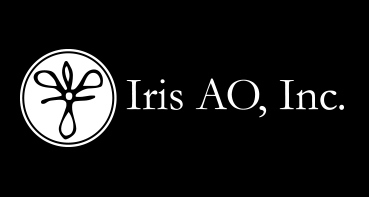
New Adaptive Optics Module from Iris AO, Inc. and Edmund Optics Makes Wavefront Correction Easy

Iris AO realized they needed to make the unique benefits of their DM design known. A deformable mirror in isolation may be an impressive display of fabrication expertise, but it does not present the opportunity to showcase its capabilities. To demonstrate the features of their deformable mirror Iris AO created a full adaptive optics module that allowed them to image a beam, actively correct the deformable mirror, and show the resultant improvement in beam quality. The module needed a deformable mirror and a camera, along with their associated mirrors and mounts.
Edmund Optics® engineers discovered an Iris AO demonstration and noted the challenges Iris AO was facing to create and maintain beam quality. The Edmund Optics engineers had helped previous customers with those types of issues before, thus resulting in immediate discussions for improvement. The Edmund Optics team recommended Iris AO incorporate an improved camera interface, stabilize the optical mounts, and consider optics with higher precision coatings and surface quality. By the following year the Iris AO demonstration incorporated: a simplified, more reliable camera interface featuring a CMOS monochrome USB camera, a variety of edge-blackened achromatic lenses to increase optical performance while reducing stray light and improving system signal to noise performance, enhanced aluminum mirrors to enhance system reflectance and overall transmission, and stable and repeatable Edmund Optics kinematic mounts to aid in system alignment, reduce unwanted vibration. All of these improvements were realized using standard items from Edmund Optics’ extensive product line.
Iris AO engineers realized the standalone module they had created as a demonstration tool could also function as an integrated unit that would allow users to plug adaptive optics capabilities into their own applications. The module would make it even easier for users to incorporate the power of adaptive optics into their own systems. But Iris AO customers have different needs, including applications across the spectrum, from UV to IR. To adequately serve these customers, several distinct versions of the module would be needed, each with components whose individual surface quality and coating specifications supported the overall system performance requirements. Iris AO turned to the components supplier who had already helped them produce a reliable demonstration module: Edmund Optics®.
Edmund Optics® was uniquely positioned to support the adaptive optics module development project. Edmund Optics maintains the world’s largest inventory of stock optics, offers quick turn optics modification service, and a full range of in-house optical component manufacturing capabilities. Iris AO partnered with Edmund Optics to leverage their internal design expertise as well as their broad selection of stock and custom optics to dramatically improve the performance of their system. Since Edmund Optics manufactures many of its components, part specifications and processes are fully documented and controlled, giving customers, like Iris AO, the confidence that they will be able to get high quality components through the entire product lifecycle from design to prototype to volume production. Edmund Optics’ extensive line of stock optomechanics and high quality cameras also meant that Iris AO did not have to compromise product specifications when optimizing their system design.
For example, the Iris AO deformable mirrors are robust enough to function in a controlled environment, with humidity of less than 40%, without additional protection. As insurance against inadvertent contact or particulate contamination of the mirror surface, Iris AO decided to package their DM with a cover window. The problem is that a window can degrade optical transmission, reflect “ghost images,” or introduce undetected wavefront errors into the optical train. Iris AO also didn’t want to introduce a window that would not support the high laser damage threshold of their DM. They designed their own window as a modification of a standard optic using Edmund Optics’ in-house prototyping capabilities. The Iris AO-Edmund customized windows are 20mm in diameter, 3mm thick, have λ/20 surface flatness, and are coated with an optimized VIS-NIR anti-reflection coating.
The camera was also selected to meet the systems’ needs. A fast interface and easy camera configuration are critical to take advantage of the unique control system architectures possible with the Iris AO DM. Edmund Optics engineers recommended a simple and fast USB camera interface allowing for easy configurability with common lab software.
During the process of assisting Iris AO with their module design, Edmund Optics engineers realized that this kind of adaptive optics capability could be of great use to many of their customers. The final step in the collaboration between these two companies at the forefront of optics innovation was the agreement that Edmund Optics® would offer the Iris AO adaptive optics module to their customer base (Edmund Optics stock number #33-740).
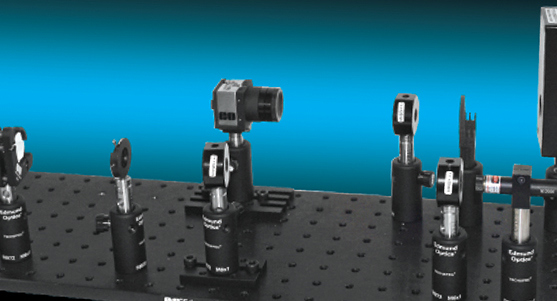
Typically, designers who incorporate adaptive optics into their systems need to use their deformable mirror with a wavefront sensor. Signals from the wavefront sensor give an estimate of the deviations from a perfect beam or flat wavefront. When processed by the computer, the deviation signals from the wavefront sensor are converted to a set of voltages used to control the actuators on the deformable mirror. To ensure the beam is properly corrected, voltages at the deformable mirror must be correlated with their effect on signals at the wavefront sensor. Unfortunately, for most deformable mirrors the relationship between actuator voltages and wavefront sensor measurements frequently shifts, because of mechanical or thermal drifts of the deformable mirror, or instabilities elsewhere in the optical path - the Iris AO module avoids this common interaction resulting in easier use.
To begin with, the standard module skips the wavefront sensor altogether. That’s possible because Iris AO’s unique deformable mirror design is so stable that the relationship between actuator voltages and segment displacement stays constant over time. The mirrors are calibrated prior to shipment, and that calibration remains effective for several years.
The stability enables a simpler method of wavefront correction. The control system works by evaluating the image quality while running the deformable mirror through a series of predefined shapes. Of course, with a circular aperture the most convenient shapes are the Zernike functions. As the mirror scans through a set of up to 55 Zernike functions the software tracks the image quality. The algorithm combines the best magnitude of each Zernike function to produce a set of actuator control voltages that optimize the overall image quality.
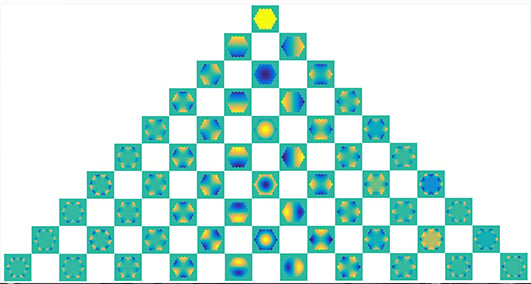
The adaptive optics module represents the results possible when two organizations collaborate to leverage their individual strengths. Iris AO has a unique deformable mirror architecture and in-depth knowledge of innovative control system design. Edmund Optics® has a broad knowledge of optical component capabilities, from specialized optical coatings to camera characteristics, as well as stable and repeatable mounts necessary to support rigorous performance specifications. The stability of the mirror, the quality of the optics, the clarity of the camera interface, and the simplicity of the control algorithm all combine to make the adaptive optics module a “plug-and-play” subsystem. The new module provides the power of adaptive optics with the ease-of-integration of fixed components. For the first time, designers can compensate for inherent aberrations of their applications without needing to master the complexity of phase measurement and wavefront reconstruction.
Designers of high-performance optical systems put a lot of effort into making those systems as perfect as possible. When they succeed, they produce an optical system whose performance is limited by the fundamental physical behavior of light, a so-called diffraction-limited system. That means the fabrication inaccuracies and alignment tolerances are so small that they don’t influence the image quality at all. Near perfection of the optics, however, doesn’t help much when the object is being imaged through a distorting medium.
For example, astronomers spend a lot of time and money building very large telescopes to create perfect images of distant stars. When the light enters the atmosphere, however, it propagates unevenly, with some portions of the wavefront being delayed with respect to others. The different propagation delays across the aperture of the telescope cause the wavefront to distort, which means the telescope can no longer produce tight, crisp images. In the past the only option for astronomers was to wait for “good seeing,” that is, good atmospheric propagation conditions. The larger the telescope aperture, though, the more likely there will be significant aberration of the beam, even in good conditions.
A few decades ago, a series of technical breakthroughs led to an invention that opened up possibilities for ever larger telescopes: adaptive optics. An adaptive optical system senses aberrations in a beam, then modifies the shape of a deformable mirror to compensate for the propagation errors induced by the medium. Now it is possible to create diffraction-limited images from telescopes many meters in diameter.
Astronomy is not the only field benefitting from adaptive optics. Retinal imaging has also been drastically improved by adaptive optics. The media within the eye disrupts optical propagation in the same way as the atmosphere. A couple decades ago, researchers and clinicians who wanted to image the retina had few options, and a fuzzy view was the best they could get. By incorporating adaptive optics into their imaging systems they can now produce images that clearly show single cells in the retina.
Adaptive optics technology has rapidly advanced, opening up new applications with those two fields leading the way. For example, adaptive optics can correct for beam distortions prevalent in laser welding or aberrations that limit the speed of free-space optical communications. Adaptive optics can even be used in applications where aberrant media are not really a problem, as in coherent beam combining. As the technology becomes more capable and easier to use, undoubtedly new applications will arise.
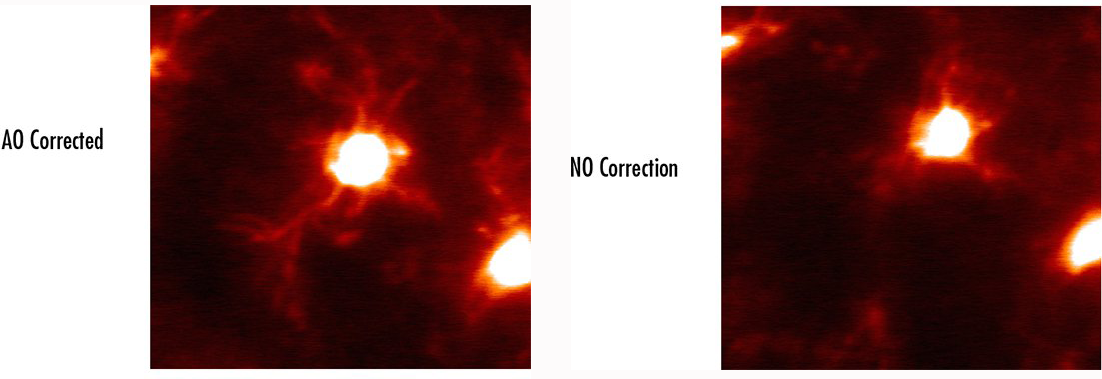
Deformable mirrors are at the heart of adaptive optics systems. As implicit in their name, deformable mirrors can change their shape in response to a set of control signals. The control signals are routed to individual actuators, which change their length depending upon the voltage driving them. The spacing, positioning, and length of stroke of the actuators varies across different models of deformable mirrors. Deformable mirrors come in two distinct types: continuous face sheet and segmented mirror.
A continuous face sheet deformable mirror is built from a single thin reflective membrane, which then has actuators attached to its back side. Segmented mirrors are made up of individual pieces of reflective material, each piece with an actuator or actuators attached. Actuators can be of many types, including piezoelectric and electrostatically driven.
The Iris AO deformable mirror is a segmented design, with each hexagonal segment driven by three electrostatic actuators. Without going into great detail about alternative designs, it’s still possible to outline some of the features and benefits of the Iris AO design.
Iris AO uses microelectromechanical systems (MEMS) technology to structure movable platforms above three symmetric electrodes. Residual stresses are built into the polysilicon during fabrication so that the hexagonal sections release themselves above the base, attached by three flexures to the substrate. Voltages on the three electrodes are controlled to change the distance between each segment platform and the substrate, and also to control the angle of the substrate with respect to the chip surface. Each segment, then, has three independent degrees of freedom: piston, tip, and tilt. The 37-segment version of the Iris AO deformable mirror thus has 111 piston-tip-tilt actuators, giving it its model number.
Another unique component of the Iris AO DM design is the independent fabrication of the reflective segments. The reflective hexagons are produced in a separate micromachining step, then flip chip bonded to the polysilicon actuator-platform arrays. This removes constraints on the segment thickness, meaning the segments are thick enough to be rigid and with an excellent surface quality (flatness better than 20nm RMS)
The positive control of the flexure/actuator assembly along with the independent fabrication of the reflective mirror segments give the Iris AO DM extraordinary stability. Once a set of voltages are applied to create a specific mirror profile, that profile will remain unchanged until the DM is turned off. In addition, the thickness of the mirror segments means the DM has a high laser damage threshold. Another big advantage to the design approach is that the calibration — the relationship between applied voltages and segment position — is set at the factory and remains accurate over several years. These features combine to make the Iris AO DM the obvious choice for many applications that can benefit from adaptive optics.
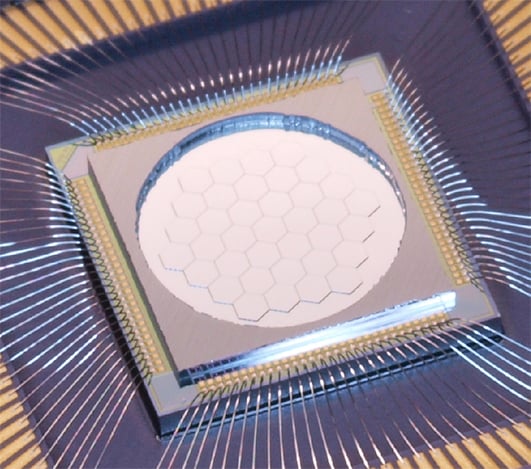
weitere regionale Telefonnummern
ANGEBOTSTOOL
Geben Sie zum Starten die Produktnummer ein.
Copyright 2023 | Edmund Optics, Ltd Unit 1, Opus Avenue, Nether Poppleton, York, YO26 6BL, UK
Die Edmund Optics GmbH Deutschland fungiert als Handelsvermittler für die Edmund Optics Ltd. in Großbritannien.
Vertragspartner ist die Edmund Optics Ltd. in Großbritannien.